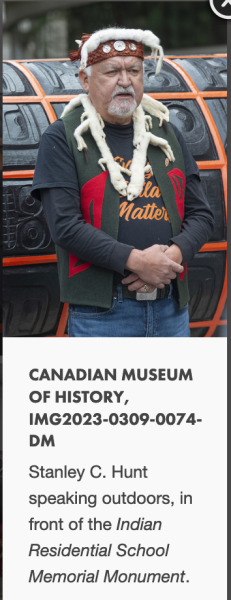 On this National Day for Truth and Reconciliation, the Canadian Museum of History is proud to officially inaugurate the Indian Residential School Memorial Monument, honouring the lives of Indigenous children removed from their families and sent to residential schools.
On this National Day for Truth and Reconciliation, the Canadian Museum of History is proud to officially inaugurate the Indian Residential School Memorial Monument, honouring the lives of Indigenous children removed from their families and sent to residential schools.
Created by Kwaguʼł master carver Stanley C. Hunt in response to the announcement that unmarked children’s graves had been found at the site of the former Kamloops Indian Residential School, this monumental work is a memorial to the children who never returned from Canada’s residential schools. Carved from the trunk of a red cedar tree, Monument is 5.5 metres (18 feet) tall and 1.2 metres (4 feet) wide, and features 130 unsmiling children’s faces. A large raven looks down upon them protectively. Emblems such as the maple leaf and cross, and abbreviations for the Royal Canadian Mounted Police and North-West Mounted Police, have been carved upside down.
“I will remember the day we heard about the children in Kamloops. No words in any language could be put together to make this make sense,” said Stanley C. Hunt. “Now that time has passed, it will never make any sense to any of our people. I built this monument to honour our children and to give all our people some things we can focus on when our minds remember.”
Monument’s display at the Museum of History provides new opportunities to spark national conversations related to the residential school system and the ongoing work of reconciliation in Canada. It is the Museum’s hope that visitors will not only be moved by Monument‘s rich symbolism, but also be inspired to engage in thoughtful discussion and reflection around a difficult chapter in this country’s evolving story.
“Monument is, of course, a stunning work of art. However, it is much more than that. It is a testament to one of the very dark chapters in this country’s history,” said Caroline Dromaguet, President and Chief Executive Officer of the Canadian Museum of History. “We are honoured to welcome such an important work. Its prominent placement in its own dedicated space will ensure that the children of this country’s residential school system are never forgotten. It is our shared responsibility to listen, bear witness, and work towards a better shared future.”
Now on permanent display in the Four Seasons Salon, the Indian Residential School Memorial Monument is not a traditional pole or memorial pole. It is unique. Visitors who view Monument are invited to become witnesses to truth, and to contribute to a future of reconciliation.
Listen to Stanley C. Hunt’s episode of Artifactuality (above), the Museum’s podcast, and read the blog post about his story, this monumental sculpture, and the importance of truth-telling when it comes to residential schools and reconciliation in Canada.
- Ice Candle Celebration cancelled for 2025 - December 19, 2025
- School Bus Cancellations - December 19, 2025
- Ladies Curling Standings – December 18th - December 18, 2025
 Wawa-news.com You can't hear the 'big picture'!
Wawa-news.com You can't hear the 'big picture'!